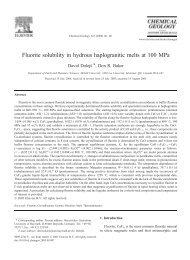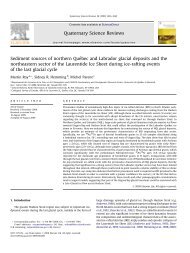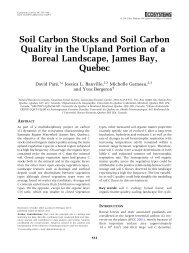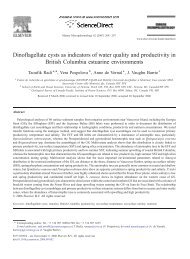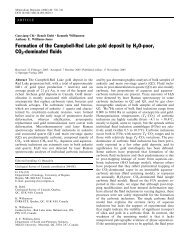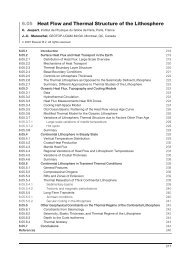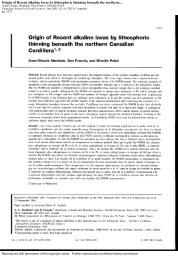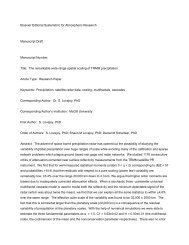Caldera subsidence in areas of variable topographic relief ... - UQAM
Caldera subsidence in areas of variable topographic relief ... - UQAM
Caldera subsidence in areas of variable topographic relief ... - UQAM
You also want an ePaper? Increase the reach of your titles
YUMPU automatically turns print PDFs into web optimized ePapers that Google loves.
R<br />
Available onl<strong>in</strong>e at www.sciencedirect.com<br />
Journal <strong>of</strong> Volcanology and Geothermal Research 129 (2004) 219^236<br />
www.elsevier.com/locate/jvolgeores<br />
<strong>Caldera</strong> <strong>subsidence</strong> <strong>in</strong> <strong>areas</strong> <strong>of</strong> <strong>variable</strong> <strong>topographic</strong> <strong>relief</strong>:<br />
results from analogue model<strong>in</strong>g<br />
Yan Lavalle¤e a; , John Stix b , Ben Kennedy b , Mathieu Richer b ,<br />
Marc-Anto<strong>in</strong>e Longpre¤ b<br />
b<br />
a<br />
Department <strong>of</strong> Space Studies, University <strong>of</strong> North Dakota, Grand Forks, ND 58202, USA<br />
Department <strong>of</strong> Earth and Planetary Sciences, McGill University, 3450 University Street, Montreal, Qc, Canada H3A 2A7<br />
Received 16 July 2002; accepted 17 March 2003<br />
Abstract<br />
<strong>Caldera</strong>s form <strong>in</strong> volcanic <strong>areas</strong> commonly associated with <strong>topographic</strong> <strong>relief</strong>. Pre-exist<strong>in</strong>g topography plays an<br />
important role <strong>in</strong> the style <strong>of</strong> the caldera <strong>subsidence</strong>; topography <strong>in</strong>creases the load and affects the pr<strong>in</strong>ciple stress<br />
trajectories located between the ro<strong>of</strong> <strong>of</strong> the magma chamber and the surface. The morphology, <strong>in</strong>ternal structure, and<br />
temporal evolution <strong>of</strong> calderas are therefore sensitive to the local topography. We carried out scaled analogue<br />
experiments to <strong>in</strong>vestigate the effect <strong>of</strong> pre-exist<strong>in</strong>g <strong>topographic</strong> <strong>relief</strong> on caldera <strong>subsidence</strong> by model<strong>in</strong>g the presence<br />
<strong>of</strong> stratocones and plateaus, <strong>of</strong> <strong>variable</strong> mass, diameter and positions, prior to collapse. We <strong>in</strong>duced collapse <strong>in</strong><br />
sandbox experiments by withdraw<strong>in</strong>g water from a rubber bladder to simulate caldera collapse <strong>in</strong>to a large, shallow<br />
reservoir. Deformation was first manifested by sagg<strong>in</strong>g <strong>of</strong> the sand at the surface, followed by the upward<br />
propagation <strong>of</strong> a set <strong>of</strong> <strong>subsidence</strong>-controll<strong>in</strong>g faults from the bladder. In experiments with no topography, these<br />
faults usually reached the surface near the centre <strong>of</strong> the cyl<strong>in</strong>der. As evacuation and <strong>in</strong>cremental growth progressed, a<br />
second outer set <strong>of</strong> <strong>subsidence</strong>-controll<strong>in</strong>g faults developed; this outer set dom<strong>in</strong>ated the <strong>subsidence</strong>. By <strong>in</strong>creas<strong>in</strong>g the<br />
<strong>topographic</strong> load by 6%, the <strong>subsidence</strong> efficiency <strong>in</strong>creased, produc<strong>in</strong>g calderas up to approximately 20% deeper. The<br />
<strong>in</strong>ner set <strong>of</strong> <strong>subsidence</strong>-controll<strong>in</strong>g faults steepened and controlled most <strong>of</strong> the collapse, by contrast to the experiments<br />
without topography. Add<strong>in</strong>g load also reduced outward growth <strong>of</strong> peripheral sagg<strong>in</strong>g and development <strong>of</strong> extensional<br />
faults; lead<strong>in</strong>g to a diameter <strong>of</strong> sagg<strong>in</strong>g 20% smaller than with no topography. A comparative analysis <strong>of</strong> our results<br />
with Mount Mazama at Crater Lake, Oregon, and Glass Mounta<strong>in</strong> at Long Valley, California, supports the<br />
<strong>in</strong>terpretation that the addition <strong>of</strong> <strong>topographic</strong> load modifies the evolution <strong>of</strong> the major caldera faults.<br />
ß 2003 Elsevier B.V. All rights reserved.<br />
Keywords: caldera <strong>subsidence</strong>; analogue model<strong>in</strong>g; r<strong>in</strong>g fault; topography<br />
1. Introduction<br />
* Correspond<strong>in</strong>g author. Tel.: +1-701-777-3460;<br />
Fax: +1-701-777-3711.<br />
E-mail address: yanlavallee@hotmail.com (Y. Lavalle¤e).<br />
Despite many years <strong>of</strong> research on large silicic<br />
caldera systems, we do not yet have a comprehensive<br />
understand<strong>in</strong>g <strong>of</strong> the formation <strong>of</strong> these calderas<br />
for several reasons. First, ¢eld observations<br />
at young calderas are limited because the depres-<br />
0377-0273 / 03 / $ ^ see front matter ß 2003 Elsevier B.V. All rights reserved.<br />
doi:10.1016/S0377-0273(03)00241-5
220<br />
Y. Lavalle¤e et al. / Journal <strong>of</strong> Volcanology and Geothermal Research 129 (2004) 219^236<br />
sions are ¢lled with large accumulations <strong>of</strong> ignimbrite<br />
and therefore conceal the deeper <strong>in</strong>ternal<br />
structures. Second, the rare occurrence and the<br />
violent nature <strong>of</strong> large ignimbrite eruptions dur<strong>in</strong>g<br />
caldera <strong>subsidence</strong> make it di⁄cult or impossible<br />
to directly view the mechanisms <strong>of</strong> caldera formation.<br />
Third, complexities such as pre-exist<strong>in</strong>g<br />
faults and other crustal heterogeneities appear to<br />
play an important role dur<strong>in</strong>g the process <strong>of</strong> caldera<br />
<strong>subsidence</strong> (e.g. Riller et al., 2001), but these<br />
factors are as yet poorly constra<strong>in</strong>ed.<br />
<strong>Caldera</strong>s have been the subject <strong>of</strong> numerous<br />
¢eld studies (e.g. Smith and Bailey, 1968; Walker,<br />
1984; Lipman, 1984; Branney, 1995; Moore and<br />
Kokelaar, 1998), and their formation also has<br />
been studied theoretically (Druitt and Sparks,<br />
1984; Gudmundsson, 1988, 1998; Gudmundsson<br />
et al., 1997; Scandone, 1990). The temporal evolution<br />
<strong>of</strong> calderas recently has been <strong>in</strong>vestigated<br />
us<strong>in</strong>g scaled physical models (Komuro et al.,<br />
1984; Komuro, 1987; Mart|¤ et al., 1994; Roche<br />
et al., 2000; Acocella et al., 2000, 2001; Kennedy<br />
et al., <strong>in</strong> press). These models have used a £at<br />
horizontal topography, despite the fact that this<br />
is rarely the case <strong>in</strong> nature. Instead, calderas form<br />
<strong>in</strong> volcanic ¢elds which usually are associated<br />
with signi¢cant <strong>topographic</strong> <strong>relief</strong>. Topographic<br />
<strong>relief</strong> is expressed as a mass dispersed over a given<br />
area, which a¡ects the load imposed on the underly<strong>in</strong>g<br />
magma chamber (Kennedy, 2000).<br />
At some volcanic complexes such as Crater<br />
Lake caldera, Oregon, the <strong>topographic</strong> load is<br />
the dom<strong>in</strong>ant upper-crustal stress ¢eld (Bacon,<br />
1983). Scaled experiments have shown that volcano<br />
load<strong>in</strong>g modi¢es the regional fault patterns,<br />
<strong>in</strong>creases the fault throw and <strong>in</strong>duces extension<br />
(Van Wyk de Vries and Merle, 1996, 1998; Merle<br />
and Borgia, 1996). These researchers model and<br />
expla<strong>in</strong> these volcano-load<strong>in</strong>g e¡ects by a ductile<br />
layer which spreads outward below the volcano.<br />
There has been recent <strong>in</strong>terest <strong>in</strong> the e¡ects <strong>of</strong><br />
pre-exist<strong>in</strong>g <strong>topographic</strong> <strong>relief</strong> upon the dynamics<br />
<strong>of</strong> caldera <strong>subsidence</strong> (Kennedy, 2000; Walter<br />
and Troll, 2001; Troll et al., 2002; Kennedy et<br />
al., <strong>in</strong> press). The presence <strong>of</strong> <strong>relief</strong> <strong>in</strong>creases the<br />
load and shifts stress trajectories located between<br />
the ro<strong>of</strong> <strong>of</strong> the magma chamber and the ground<br />
surface (Fig. 1). Pr<strong>in</strong>cipal stress trajectories are<br />
oriented perpendicular to the free surfaces (Jaeger<br />
and Cook, 1969) and therefore are a¡ected by<br />
topography. Stress trajectories are concentrated<br />
where the curvature <strong>of</strong> the free surface is greatest,<br />
<strong>in</strong> this case at the basal marg<strong>in</strong> <strong>of</strong> the topography<br />
and where the magma chamber ro<strong>of</strong> becomes<br />
curved. Hence, the morphology, <strong>in</strong>ternal structure<br />
and temporal evolution <strong>of</strong> caldera <strong>subsidence</strong> can<br />
be a¡ected by topography.<br />
With this <strong>in</strong> m<strong>in</strong>d, our objectives were to understand<br />
the consequences <strong>of</strong> vary<strong>in</strong>g the <strong>in</strong>itial load<br />
us<strong>in</strong>g various geometric forms similar to volcanic<br />
edi¢ces, such as cones and plateaus. Speci¢cally,<br />
the present study aims to elucidate several aspects<br />
<strong>of</strong> pre-exist<strong>in</strong>g <strong>topographic</strong> <strong>relief</strong> on the behaviour<br />
<strong>of</strong> caldera <strong>subsidence</strong>. Three <strong>variable</strong>s were <strong>in</strong>vestigated<br />
for this study: (1) <strong>topographic</strong> mass, (2)<br />
<strong>topographic</strong> diameter, and (3) volcanic construct<br />
position<strong>in</strong>g relative to the centre <strong>of</strong> the analogue<br />
magma chamber.<br />
2. Methodology<br />
2.1. Scal<strong>in</strong>g relationships<br />
In order to model natural processes, we scaled<br />
down experimental parameters by adher<strong>in</strong>g to the<br />
pr<strong>in</strong>ciples <strong>of</strong> similitude (Hubbert, 1937). This scal<strong>in</strong>g<br />
validated that our model is mechanically, k<strong>in</strong>ematically<br />
and dynamically comparable to the<br />
natural case (Sanford, 1959).<br />
<strong>Caldera</strong>s are large volcanic depressions rang<strong>in</strong>g<br />
from 2 to more than 50 km <strong>in</strong> diameter (Lipman,<br />
1984). The cyl<strong>in</strong>der used <strong>in</strong> our experiments has a<br />
diameter <strong>of</strong> 1.0 m, so we assume that a 0.50-mdiameter<br />
experimental caldera is equivalent to a<br />
20-km-diameter natural caldera:<br />
L ¼ d D ¼<br />
0:5 m<br />
20000 m ¼ 2:5U1035<br />
where d is the diameter <strong>of</strong> the experimental caldera,<br />
D is the diameter <strong>of</strong> the natural caldera, and<br />
L* is the length ratio. L* is relevant for the dimensions<br />
<strong>of</strong> topography, caldera and magma<br />
chamber aspect ratio (depth/diameter ratio <strong>of</strong><br />
the ro<strong>of</strong> <strong>of</strong> the analogue chamber). Thus, the<br />
8.5-cm depth <strong>of</strong> the analogue chamber constantly
Y. Lavalle¤e et al. / Journal <strong>of</strong> Volcanology and Geothermal Research 129 (2004) 219^236 221<br />
Fig. 1. Stress trajectories between a pressurised magma chamber and the surface, where the vertical load (c 1 ) is the sole stress applied.<br />
(a) No <strong>topographic</strong> <strong>relief</strong>. (b) In the presence <strong>of</strong> a plateau. (c) In the presence <strong>of</strong> a cone. (d) In the presence <strong>of</strong> a cone located<br />
above the edge <strong>of</strong> the analogue chamber. The ¢gures are purely qualitative and designed to illustrate how the orientation<br />
<strong>of</strong> the free surface alters the orientation <strong>of</strong> the stress trajectories. Fault<strong>in</strong>g is most likely where stress trajectory concentrations<br />
are highest; these regions are marked by a X. Modi¢ed from Jaeger and Cook (1969).<br />
used <strong>in</strong> our experiments corresponds to a 3.4-kmdeep<br />
magma chamber.<br />
Time is another fundamental parameter that<br />
needs to be scaled (Hubbert, 1937). Shear box<br />
tests and some prelim<strong>in</strong>ary experiments have demonstrated<br />
that time is an important factor, as sand<br />
deformation may be partially time-dependent.<br />
The duration <strong>of</strong> caldera formation is poorly constra<strong>in</strong>ed.<br />
While Wilson and Hildreth (1997) estimated<br />
that the collapse <strong>of</strong> Long Valley caldera<br />
took approximately 98 h, the caldera-form<strong>in</strong>g<br />
eruption <strong>of</strong> P<strong>in</strong>atubo <strong>in</strong> 1991 lasted approximately<br />
9 h (Wolfe and Hoblitt, 1996). For our<br />
scal<strong>in</strong>g, we chose a mean value <strong>of</strong> 17 h for a<br />
natural caldera and a 5-m<strong>in</strong> evacuation time for<br />
the experiments (t). The time ratio, d*, is:<br />
d ¼ t T ¼<br />
5 m<strong>in</strong><br />
1020 m<strong>in</strong> ¼ 4:9U1033<br />
The appropriate experimental material is determ<strong>in</strong>ed<br />
by scal<strong>in</strong>g the shear strength <strong>of</strong> crustal<br />
rocks. The stress ratio, c*, can be used for this<br />
and is equivalent to the density ratio, b*, multiplied<br />
by the gravity ratio, g*, and L*:<br />
c ¼b g L ¼1:8U10 35 to 2:4U10 35<br />
where b* = 0.70^0.95 (density <strong>of</strong> partially compacted<br />
sand 1890 kg m 33 , density <strong>of</strong> rocks<br />
2000^2700 kg m 33 ) and g* = 1. The gravity ratio<br />
obta<strong>in</strong>ed from our scal<strong>in</strong>g ratios (units <strong>of</strong> m/s 2<br />
and therefore L*/T* 2 ) is approximately 1, support<strong>in</strong>g<br />
the gravitational conditions under which<br />
the experiments were performed.<br />
Crustal rocks have a cohesion on the order <strong>of</strong><br />
10 6 to 10 7 Pa depend<strong>in</strong>g on fractur<strong>in</strong>g (Schultz,<br />
1996). Scal<strong>in</strong>g cohesion us<strong>in</strong>g the stress ratio<br />
therefore requires the use <strong>of</strong> material with a<br />
very low cohesion (18^240 Pa). In theory, sand<br />
consists <strong>of</strong> cohesionless particles held by static<br />
friction (Krantz, 1991; Wittmer et al., 1996). We<br />
used poorly-sorted, partially compacted sand that<br />
has absorbed some moisture from the air. Due to<br />
its poor sort<strong>in</strong>g and slight humidity, the sand has<br />
acquired a small amount <strong>of</strong> cohesion which is<br />
appropriate for our experiments. Attempts to es-
222<br />
Y. Lavalle¤e et al. / Journal <strong>of</strong> Volcanology and Geothermal Research 129 (2004) 219^236<br />
timate the cohesion were made us<strong>in</strong>g shear box<br />
tests, but the low cohesion values were di⁄cult<br />
to estimate. We concluded that a value <strong>of</strong> 0^100<br />
Pa was reasonable, which is equivalent to the<br />
scaled strength <strong>of</strong> crustal rocks <strong>in</strong> nature.<br />
The viscosity <strong>of</strong> the magma also needs to be<br />
considered <strong>in</strong> the scal<strong>in</strong>g process, s<strong>in</strong>ce it is an<br />
important <strong>variable</strong> dependent on three fundamental<br />
parameters: mass, length and time. The viscosity<br />
ratio, R*, is thus:<br />
R ¼d c ¼8:8U10 38 to 1:2U10 37<br />
The viscosity <strong>of</strong> magmas varies from 10 2 Pa s<br />
for basaltic melts up to 10 18 Pa s for anhydrous<br />
granitic melts (Murase and McBirney, 1973; Hess<br />
and D<strong>in</strong>gwell, 1996). We decided to scale our analogue<br />
material us<strong>in</strong>g a magma viscosity <strong>of</strong> 10 4^10 5<br />
Pa s, as this viscosity spans a wide range <strong>of</strong> magma<br />
compositions (e.g. dry andesitic melt to granitic<br />
melt conta<strong>in</strong><strong>in</strong>g 4 wt% H 2 O at 900‡C; Hess<br />
and D<strong>in</strong>gwell, 1996). We used water with a viscosity<br />
<strong>of</strong> 10 33 Pa s as our analogue material, because<br />
it is consistent with our scal<strong>in</strong>g factor.<br />
2.2. Experimental setup<br />
The apparatus comprised a cyl<strong>in</strong>der 1.0 m <strong>in</strong><br />
diameter and 1.0 m <strong>in</strong> height, ¢lled with poorlysorted,<br />
partially compacted sand, which represents<br />
brittle crustal rock (Fig. 2a). A 45-l water-<br />
¢lled rubber bladder was buried with<strong>in</strong> the sand<br />
to represent a magma chamber. The analogue<br />
chamber, circular <strong>in</strong> plan view and oblate <strong>in</strong> section,<br />
deformed <strong>in</strong> two di¡erent ways dur<strong>in</strong>g the<br />
experiments. When ¢lled with water to its maximum<br />
capacity, the analogue chamber de£ated<br />
elastically and contracted due to overpressure decrease<br />
(Fig. 2b). At lower water capacities, however,<br />
the ro<strong>of</strong> subsided vertically as the water was<br />
evacuated (Fig. 2c). These two mechanisms <strong>of</strong><br />
analogue chamber deformation represent <strong>in</strong>itially<br />
elastic behaviour <strong>of</strong> the crust and the crystal mush<br />
around the chamber dur<strong>in</strong>g contraction as the<br />
pressure <strong>in</strong> the magma chamber was decreased,<br />
followed by brittle failure <strong>of</strong> the ro<strong>of</strong> when the<br />
deviatoric stress reached the Mohr^Coulomb criterion<br />
curve (Hubbert, 1951; Mandl, 1988).<br />
Fig. 2. (a) Experimental setup show<strong>in</strong>g a cyl<strong>in</strong>der conta<strong>in</strong><strong>in</strong>g sand. The cyl<strong>in</strong>der has a diameter <strong>of</strong> 1.0 m, a height <strong>of</strong> 1.0 m, and<br />
is ¢lled with poorly-sorted, compacted sand. The rubber bladder, buried at a depth <strong>of</strong> 0.085 m, has a diameter <strong>of</strong> 0.60 m and is<br />
¢lled <strong>in</strong>itially with 45 l <strong>of</strong> water. Two lasers are <strong>in</strong>cl<strong>in</strong>ed at an angle <strong>of</strong> 30‡; they produce two perpendicular l<strong>in</strong>es on the surface.<br />
(b) Deformation <strong>of</strong> the bladder dur<strong>in</strong>g <strong>in</strong>itial withdrawal. The bladder contracts, similar to a magma chamber los<strong>in</strong>g volatiles as<br />
the gas-rich magma erupts. (c) Schematic representation <strong>of</strong> the bladder deformation at a later stage, where the ro<strong>of</strong> subsides vertically.<br />
This stage represents the <strong>subsidence</strong> <strong>of</strong> the ro<strong>of</strong> <strong>in</strong>to the magma chamber.
Y. Lavalle¤e et al. / Journal <strong>of</strong> Volcanology and Geothermal Research 129 (2004) 219^236 223<br />
Magma withdrawal was simulated us<strong>in</strong>g a tube<br />
attached to the underside <strong>of</strong> the analogue chamber,<br />
with a £owmeter to control the rate <strong>of</strong> water<br />
evacuation. Subsidence was thus a consequence <strong>of</strong><br />
depressurisation <strong>in</strong> the magma chamber; after the<br />
<strong>in</strong>itial contraction, the weight <strong>of</strong> the overly<strong>in</strong>g<br />
sand was the only stress act<strong>in</strong>g on the system<br />
(no far-¢eld stress was present). Two lasers positioned<br />
at right angles to each other and <strong>in</strong>cl<strong>in</strong>ed<br />
at 30‡ produced two <strong>in</strong>itially perpendicular<br />
straight l<strong>in</strong>es on the surface <strong>of</strong> the sand. As water<br />
was evacuated, the <strong>subsidence</strong> <strong>of</strong> the caldera £oor<br />
was revealed by curvatures and o¡sets <strong>of</strong> the<br />
l<strong>in</strong>es. To clearly see the di¡erent structures form<strong>in</strong>g<br />
at the surface, the sand was kept as smooth<br />
as possible, and the <strong>relief</strong> was well de¢ned. Before<br />
each experiment, the sand was mixed and<br />
compacted, by moderately tamp<strong>in</strong>g the entire<br />
surface, to keep it homogeneous and to erase<br />
traces <strong>of</strong> any pre-exist<strong>in</strong>g fractures from previous<br />
experiments.<br />
In order to <strong>in</strong>vestigate the role <strong>of</strong> pre-exist<strong>in</strong>g<br />
<strong>topographic</strong> <strong>relief</strong>, all complementary <strong>variable</strong>s<br />
were kept constant. The 45-l analogue chamber<br />
was leveled and buried at a depth <strong>of</strong> 0.085 m<br />
and evacuated at a rate <strong>of</strong> 1.6 l m<strong>in</strong> 31 for 5 m<strong>in</strong>.<br />
For some experiments, the evacuation rate was<br />
600 l m<strong>in</strong> 31 for 13.3 m<strong>in</strong>. In both cases the<br />
evacuation totalled 8000 l. With the evacuation<br />
<strong>of</strong> this volume, the sand subsided by approximately<br />
0.05 m, which represents about 2000 m<br />
<strong>of</strong> <strong>subsidence</strong> accord<strong>in</strong>g to our scal<strong>in</strong>g ratio (see<br />
below). This value corresponds to the amount <strong>of</strong><br />
<strong>subsidence</strong> at large calderas (e.g. Long Valley caldera;<br />
Wallace et al., 1999).<br />
Temporal evolution <strong>of</strong> the <strong>subsidence</strong> was<br />
monitored us<strong>in</strong>g a video camera centred above<br />
the apparatus. To allow the observation <strong>of</strong> surface<br />
structures, a low-angle light was used to de-<br />
¢ne fault scarps. Interruption <strong>of</strong> the power every<br />
10 s allowed the camera to monitor the evolution<br />
<strong>of</strong> the curves produced by the lasers. To validate<br />
our observations, we made cross-sections for selected<br />
experiments. For these, we used alternat<strong>in</strong>g<br />
layers <strong>of</strong> white and brown sand. After an experiment,<br />
the dry sand was saturated with water,<br />
which raised the cohesion and allowed cross-section<strong>in</strong>g<br />
<strong>in</strong> order to perform fault analysis.<br />
2.3. Description <strong>of</strong> the experiments<br />
The e¡ect <strong>of</strong> add<strong>in</strong>g topography was studied by<br />
perform<strong>in</strong>g two sets <strong>of</strong> experiments with centred<br />
sandpiles <strong>of</strong> similar basal diameters, but di¡erent<br />
masses. We ran an <strong>in</strong>itial set <strong>of</strong> experiments with<br />
no pre-exist<strong>in</strong>g <strong>topographic</strong> <strong>relief</strong>, followed by experiments<br />
with 0.17-m-diameter constructs: small<br />
plateaus <strong>of</strong> 0.25 kg, thicker plateaus <strong>of</strong> 0.5 kg,<br />
and 1-kg cones (sand at the angle <strong>of</strong> repose) (Table<br />
1). The presence <strong>of</strong> these volcanic constructs<br />
<strong>in</strong>creased the average load by about 4, 7 and 14%,<br />
respectively. The second set <strong>of</strong> experiments was a<br />
repetition <strong>of</strong> the ¢rst, but the masses were all<br />
doubled, and the result<strong>in</strong>g basal diameter <strong>of</strong> the<br />
topography was 0.25 m <strong>in</strong>stead <strong>of</strong> 0.17 m. This<br />
second set thus consisted <strong>of</strong> experiments with<br />
0.5- and 1-kg plateaus and a 2-kg cone, which<br />
<strong>in</strong>creased the load by 3, 6 and 12%, respectively.<br />
Even though the masses <strong>of</strong> the sandpiles<br />
were doubled <strong>in</strong> the second set <strong>of</strong> experiments,<br />
the <strong>in</strong>crease <strong>in</strong> load was less because the area<br />
<strong>of</strong> sand distribution <strong>in</strong>creased more than did the<br />
mass.<br />
The same two sets <strong>of</strong> experiments also were<br />
used to <strong>in</strong>vestigate the e¡ect <strong>of</strong> chang<strong>in</strong>g the diameter<br />
<strong>of</strong> <strong>topographic</strong> <strong>relief</strong> on the behaviour <strong>of</strong><br />
caldera collapse. We compared experiments with<br />
no <strong>topographic</strong> <strong>relief</strong> and experiments with 0.5-kg<br />
plateaus hav<strong>in</strong>g a basal diameter <strong>of</strong> 0.17 and 0.25<br />
m. We also compared experiments with no topography,<br />
experiments with 1-kg cones 0.17 m <strong>in</strong> diameter,<br />
and 1-kg plateaus 0.25 m <strong>in</strong> diameter.<br />
Lastly, the e¡ect <strong>of</strong> topography position<strong>in</strong>g on<br />
caldera <strong>subsidence</strong> was studied by build<strong>in</strong>g a<br />
1-kg conical sandpile, 0.17 m <strong>in</strong> diameter, above<br />
the edge <strong>of</strong> the magma chamber. The o¡-centred<br />
topography experiments were compared with<br />
those done us<strong>in</strong>g a 1-kg cone centred above the<br />
magma chamber.<br />
To verify the consistency <strong>of</strong> our results, one<br />
experiment with no topography was performed<br />
between each set <strong>of</strong> topography experiments.<br />
This acted as a reference to compare with experiments<br />
hav<strong>in</strong>g pre-exist<strong>in</strong>g <strong>topographic</strong> <strong>relief</strong>. Each<br />
type <strong>of</strong> experiment was performed three times,<br />
which allowed some quantitative analysis <strong>in</strong> addition<br />
to the qualitative <strong>in</strong>terpretation.
224<br />
Y. Lavalle¤e et al. / Journal <strong>of</strong> Volcanology and Geothermal Research 129 (2004) 219^236<br />
Table 1<br />
Quantitative and qualitative results obta<strong>in</strong>ed from the experimentS<br />
Experiment<br />
number<br />
Topographic variation<br />
Results<br />
Type Size Mass Depth Diameter <strong>of</strong><br />
<strong>in</strong>ner faults<br />
Diameter <strong>of</strong><br />
outer faults<br />
Diameter <strong>of</strong><br />
sagg<strong>in</strong>g<br />
<strong>Caldera</strong> type Set <strong>of</strong> faults<br />
controll<strong>in</strong>g the<br />
<strong>subsidence</strong><br />
(m) (kg) (cm) (cm) (cm) (cm)<br />
10 no topography 0 0 4.5 10 21 63 trapdoor outer set <strong>of</strong> faults<br />
11 no topography 0 0 4.5 18 30 56 asymmetric outer set <strong>of</strong> faults<br />
piston<br />
15 no topography 0 0 4.1 13U17 29U32 63 asymmetric outer set <strong>of</strong> faults<br />
piston<br />
19 no topography 0 0 4.7 20 32 52U60 trapdoor outer set <strong>of</strong> faults<br />
24 no topography 0 0 5 15 23 64 trapdoor outer set <strong>of</strong> faults<br />
27 no topography 0 0 4 20 38 58 trapdoor outer set <strong>of</strong> faults<br />
33 no topography 0 0 4 18U22 36 65U68 trapdoor outer set <strong>of</strong> faults<br />
3 b no topography 0 0 4.2 16U18 37U42 52U58 piston outer set <strong>of</strong> faults<br />
18 plateau 0.17 0.25 4 17 27 60 trapdoor both controlled<br />
equally<br />
20 plateau 0.17 0.25 5 24 51 70 trapdoor outer set <strong>of</strong> faults<br />
16 plateau 0.17 0.5 5 17U23 30U37 60 trapdoor <strong>in</strong>ner set <strong>of</strong> faults<br />
17 plateau 0.17 0.5 5 17U26 38 57 trapdoor <strong>in</strong>ner set <strong>of</strong> faults<br />
12 cone 0.17 1 5 13U31 46 50 asymmetric <strong>in</strong>ner set <strong>of</strong> faults<br />
piston<br />
13 cone 0.17 1 5 22U33 46 50 piston <strong>in</strong>ner set <strong>of</strong> faults<br />
14 cone 0.17 1 4.7 17U24 36 56 piston <strong>in</strong>ner set <strong>of</strong> faults<br />
2 b cone 0.17 1 4.6 30 36 55 piston <strong>in</strong>ner set <strong>of</strong> faults<br />
4 b cone 0.17 1 6 26 34 56 asymmetric <strong>in</strong>ner set <strong>of</strong> faults<br />
piston<br />
21 plateau 0.25 0.5 5.2 25 31 64 trapdoor outer set <strong>of</strong> faults<br />
22 plateau 0.25 0.5 4.4 12 28 69 trapdoor outer set <strong>of</strong> faults<br />
23 plateau 0.25 0.5 5.2 28 32 65 trapdoor both controlled<br />
equally<br />
28 plateau 0.25 1 5.1 25 38 63 trapdoor <strong>in</strong>ner set <strong>of</strong> faults<br />
29 plateau 0.25 1 4.7 18 28 50 asymmetric <strong>in</strong>ner set <strong>of</strong> faults<br />
piston<br />
30 cone 0.25 2 5.3 25 none 47 trapdoor <strong>in</strong>ner set <strong>of</strong> faults<br />
31 cone 0.25 2 4.7 25 33 52U46 trapdoor <strong>in</strong>ner set <strong>of</strong> faults<br />
2.4. Relevance and limitations<br />
Physical model<strong>in</strong>g <strong>of</strong> caldera formation provides<br />
useful <strong>in</strong>sights <strong>in</strong>to the <strong>in</strong>tricate process <strong>of</strong><br />
caldera formation. Although the granular nature<br />
<strong>of</strong> sand allows it to £ow, it behaves accord<strong>in</strong>g to<br />
the Mohr^Coulomb failure criterion as a brittle<br />
material similar to the upper few kilometres <strong>of</strong><br />
the crust ( 6 10 km; Sanford, 1959). Our model<br />
uses a water-¢lled rubber bladder with a convex<br />
ro<strong>of</strong> as an analogue chamber; the average ro<strong>of</strong><br />
aspect ratio is approximately 0.3. We used such<br />
a geometry because it appears to be representative<br />
<strong>of</strong> large magma chambers (e.g. Long Valley caldera;<br />
Wallace et al., 1999). The rubber bladder is<br />
the boundary between the water and the sand and<br />
may represent the crystal-mush transition between<br />
the magma and the rock. However, this boundary<br />
is not scaled and constitutes a barrier prevent<strong>in</strong>g<br />
the occurrence <strong>of</strong> physical processes such as <strong>in</strong>trusion<br />
and the collapse <strong>of</strong> crustal blocks <strong>in</strong>to a magma<br />
chamber. Such processes may a¡ect the magmatic<br />
pressure and could play a role dur<strong>in</strong>g the<br />
process <strong>of</strong> caldera formation. However, the cor-
Y. Lavalle¤e et al. / Journal <strong>of</strong> Volcanology and Geothermal Research 129 (2004) 219^236 225<br />
rectly scaled low-viscosity water allows for irregular<br />
styles <strong>of</strong> <strong>subsidence</strong> due to relatively rapid<br />
£uid £ow with<strong>in</strong> the bladder, as is the case <strong>in</strong><br />
nature. However, <strong>in</strong> contrast to a magma carry<strong>in</strong>g<br />
bubbles, water is not compressible, which may<br />
distort the fashion by which the magma chamber<br />
responds to <strong>subsidence</strong> <strong>of</strong> the overly<strong>in</strong>g crustal<br />
block.<br />
Fig. 3. Plan view images <strong>of</strong> analogue calderas dur<strong>in</strong>g the experiments. The sets <strong>of</strong> <strong>subsidence</strong>-controll<strong>in</strong>g faults are represented by<br />
dashed l<strong>in</strong>es (f 1 and f 2 ). The thicker l<strong>in</strong>es <strong>in</strong>dicate the faults with greater displacement. The extensional faults are represented by<br />
a solid l<strong>in</strong>e (e 1 ). (a^c) Fault propagation <strong>in</strong> the absence <strong>of</strong> pre-exist<strong>in</strong>g <strong>topographic</strong> <strong>relief</strong>: after 2.5 m<strong>in</strong> (a); after 4 m<strong>in</strong> (b); after<br />
5 m<strong>in</strong> (c). (d^f) Fault development when a centred 0.25-kg plateau <strong>of</strong> 0.17 m basal diameter is present: after 2.5 m<strong>in</strong> (d); after<br />
4 m<strong>in</strong> (e); after 5 m<strong>in</strong> (f). (g^i) Fault propagation when a centred 1-kg cone <strong>of</strong> 0.17 m basal diameter is present: after 2.5 m<strong>in</strong><br />
(g); after 4 m<strong>in</strong> (h); after 5 m<strong>in</strong> (i). The ¢rst faults are <strong>in</strong>itiated at the surface at the marg<strong>in</strong> <strong>of</strong> the cone, and they propagate<br />
away from the area <strong>of</strong> maximum <strong>subsidence</strong>. The faults are curvil<strong>in</strong>ear, form<strong>in</strong>g a polygonal-shaped caldera. Note the localised<br />
development <strong>of</strong> faults <strong>in</strong> the periphery when pre-exist<strong>in</strong>g topography is present. In (d^f) a fault cuts through topography.
226<br />
Y. Lavalle¤e et al. / Journal <strong>of</strong> Volcanology and Geothermal Research 129 (2004) 219^236<br />
3. Results<br />
We now describe our experimental caldera development<br />
<strong>in</strong> plan view. The results are presented<br />
<strong>in</strong> four sections (Table 1). First we describe our<br />
experiments with no pre-exist<strong>in</strong>g topography.<br />
Then we describe the changes caused by: (1) add<strong>in</strong>g<br />
<strong>topographic</strong> mass, (2) <strong>in</strong>creas<strong>in</strong>g the diameter<br />
<strong>of</strong> the topography, and (3) mov<strong>in</strong>g the topography<br />
from above the centre to above the edge <strong>of</strong><br />
the magma chamber.<br />
3.1. No <strong>topographic</strong> <strong>relief</strong><br />
In the absence <strong>of</strong> pre-exist<strong>in</strong>g topography, the<br />
evacuation <strong>of</strong> water was immediately manifested<br />
near the centre <strong>of</strong> the free surface by downsagg<strong>in</strong>g<br />
<strong>of</strong> the sand, which is de¢ned as the tilt<strong>in</strong>g <strong>of</strong> the<br />
strata towards the centre <strong>of</strong> the caldera (Branney,<br />
1995). This was followed by the propagation <strong>of</strong> a<br />
<strong>subsidence</strong>-controll<strong>in</strong>g fault (f 1 ) from the analogue<br />
chamber ro<strong>of</strong> <strong>in</strong> the area <strong>of</strong> maximal curvature<br />
(see Fig. 1) which reached the surface near<br />
the centre <strong>of</strong> the cyl<strong>in</strong>der (Fig. 3a). As evacuation<br />
cont<strong>in</strong>ued and vertical displacement <strong>in</strong>creased, f 1<br />
propagated laterally <strong>in</strong> a curvil<strong>in</strong>ear fashion away<br />
from the location <strong>of</strong> fault <strong>in</strong>itiation at the surface<br />
(Fig. 3a^c). Midway dur<strong>in</strong>g the experiment, a second<br />
set <strong>of</strong> <strong>subsidence</strong>-controll<strong>in</strong>g faults (f 2 ) usually<br />
formed outside the ¢rst set (although <strong>in</strong> a few<br />
rare cases f 1 and f 2 <strong>in</strong>tersected), re£ect<strong>in</strong>g <strong>in</strong>cremental<br />
growth <strong>of</strong> the caldera as it subsided. As f 2<br />
developed, the area <strong>of</strong> sagg<strong>in</strong>g <strong>in</strong>creased away<br />
from the centre. Once it reached its maximum<br />
extent, extensional faults (e 1 ) developed <strong>in</strong> peripheral<br />
regions, and the <strong>in</strong>wardly tilted sand began to<br />
slump and slide slowly <strong>in</strong>to the caldera. The end<br />
result typically consisted <strong>of</strong> a trapdoor-style caldera,<br />
faulted on only one side, with an elliptical<br />
area <strong>of</strong> sagg<strong>in</strong>g aligned with the trapdoor<br />
(although pistons with complete r<strong>in</strong>g faults sometimes<br />
developed). As previously observed (Kennedy,<br />
2000; Kennedy et al., <strong>in</strong> press), the position<br />
<strong>of</strong> fault <strong>in</strong>itiation was generally found to be the<br />
po<strong>in</strong>t <strong>of</strong> maximum <strong>subsidence</strong> at the end <strong>of</strong> the<br />
experiment, even though f 2 displayed greater vertical<br />
displacement than f 1 .<br />
3.2. The addition <strong>of</strong> <strong>topographic</strong> mass<br />
The addition <strong>of</strong> a small 0.25-kg plateau <strong>of</strong> 0.17<br />
m diameter did not a¡ect the development <strong>of</strong> the<br />
<strong>subsidence</strong>-controll<strong>in</strong>g faults signi¢cantly. Two<br />
sets <strong>of</strong> <strong>subsidence</strong>-controll<strong>in</strong>g faults (f 1 through<br />
the plateau and f 2 around its marg<strong>in</strong>) developed,<br />
with their <strong>in</strong>itial positions similar to experiments<br />
with no topography (Fig. 3a). Although <strong>in</strong> this<br />
example f 1 and f 2 <strong>in</strong>tersected (Fig. 3b), the <strong>subsidence</strong><br />
was still ma<strong>in</strong>ly controlled by the outermost<br />
portions <strong>of</strong> the faults (see displacements on<br />
Fig. 4. Average depth <strong>of</strong> calderas as a function <strong>of</strong> mass added at the surface. The range <strong>of</strong> depth variation is þ 0.3 cm for experiments<br />
with topography, and þ 0.5 cm for experiments without topography.
Y. Lavalle¤e et al. / Journal <strong>of</strong> Volcanology and Geothermal Research 129 (2004) 219^236 227<br />
Fig. 5. A schematic view show<strong>in</strong>g slump<strong>in</strong>g <strong>of</strong> topography,<br />
<strong>in</strong>duced by asymmetric collapse. The thick l<strong>in</strong>e represents the<br />
fault with greatest vertical throw.<br />
Fig. 3f). Similar to experiments with no topography,<br />
an extensional peripheral fault (e 1 ) formed<br />
near the end <strong>of</strong> the experiment.<br />
With <strong>in</strong>creased sandpile masses (0.5 kg, 1 kg),<br />
the ¢rst set <strong>of</strong> <strong>subsidence</strong>-controll<strong>in</strong>g faults (f 1 )<br />
developed at the basal marg<strong>in</strong> <strong>of</strong> the sandpile<br />
(Fig. 3g). In contrast to experiments without topography,<br />
a complete second set <strong>of</strong> <strong>subsidence</strong>controll<strong>in</strong>g<br />
faults (f 2 ) rarely developed; when f 2<br />
did develop, the <strong>subsidence</strong> generally rema<strong>in</strong>ed<br />
focused along f 1 (Fig. 3g^i). The ma<strong>in</strong> set <strong>of</strong> <strong>subsidence</strong>-controll<strong>in</strong>g<br />
faults always had a smaller<br />
Fig. 6. Development <strong>of</strong> sagg<strong>in</strong>g <strong>in</strong> terms <strong>of</strong> time as the subsurface bladder is evacuated progressively. The data <strong>in</strong> (a) show sagg<strong>in</strong>g<br />
for <strong>topographic</strong> elements with 0.17 m basal diameters and <strong>variable</strong> masses compared to sagg<strong>in</strong>g <strong>in</strong> the absence <strong>of</strong> topography.<br />
The sagg<strong>in</strong>g growth rate is similar for all experiments dur<strong>in</strong>g the ¢rst 3 m<strong>in</strong>. (b) The data for the di¡erent <strong>topographic</strong><br />
masses from (a) above are normalised to the data <strong>in</strong> the absence <strong>of</strong> topography. Compared to experiments without topography,<br />
the extent <strong>of</strong> sagg<strong>in</strong>g is signi¢cantly smaller when topography is present, even for masses as small as 0.25 kg. The accuracy <strong>of</strong><br />
the sagg<strong>in</strong>g diameter is þ 1 cm.
228<br />
Y. Lavalle¤e et al. / Journal <strong>of</strong> Volcanology and Geothermal Research 129 (2004) 219^236<br />
diameter than experiments with no pre-exist<strong>in</strong>g<br />
topography. With <strong>in</strong>creased <strong>topographic</strong> mass,<br />
the resultant calderas were on average 20% deeper<br />
(Fig. 4), although there is some scatter <strong>in</strong> the<br />
data, s<strong>in</strong>ce the maximum depth <strong>of</strong> the caldera<br />
£oor was sometimes di⁄cult to estimate due to<br />
the presence <strong>of</strong> topography. The <strong>subsidence</strong> asymmetry<br />
was una¡ected by the presence <strong>of</strong> additional<br />
mass, and asymmetric <strong>subsidence</strong> caused<br />
slump<strong>in</strong>g to occur on the £anks <strong>of</strong> the topography.<br />
In one extreme case, a normal fault developed<br />
with<strong>in</strong> a subsid<strong>in</strong>g cone, lead<strong>in</strong>g to slump<strong>in</strong>g<br />
<strong>of</strong> the entire construct (Fig. 5).<br />
Sagg<strong>in</strong>g also was a¡ected by the presence <strong>of</strong><br />
additional mass. The presence <strong>of</strong> topography decreased<br />
the diameter <strong>of</strong> sagg<strong>in</strong>g by about 20%<br />
(Fig. 6a). This di¡erence appears to be related<br />
to slower outward propagation <strong>of</strong> the sagg<strong>in</strong>g<br />
for experiments with topography. Dur<strong>in</strong>g the ¢rst<br />
2 m<strong>in</strong>, the rate <strong>of</strong> sagg<strong>in</strong>g propagation was similar<br />
for all experiments (Fig. 6). Beyond this po<strong>in</strong>t,<br />
however, the rate slowed when topography was<br />
present. For experiments with large masses, the<br />
e¡ects are most evident near the end <strong>of</strong> the experiments,<br />
but even a small addition <strong>of</strong> mass greatly<br />
a¡ected the ¢nal diameter <strong>of</strong> sagg<strong>in</strong>g (Fig. 6b).<br />
The pre-exist<strong>in</strong>g <strong>topographic</strong> <strong>relief</strong> also appeared<br />
to <strong>in</strong>£uence the shape <strong>of</strong> the sagg<strong>in</strong>g<br />
area. In the absence <strong>of</strong> topography, sagg<strong>in</strong>g was<br />
<strong>of</strong>ten found to be more elongate parallel to the<br />
trapdoor, creat<strong>in</strong>g an elliptical shape <strong>in</strong> plan view.<br />
The addition <strong>of</strong> a sandpile on the surface appeared<br />
to <strong>in</strong>crease the circularity by about 4%<br />
(Fig. 7).<br />
In summary, for small sandpile masses, the result<strong>in</strong>g<br />
calderas were typically all trapdoor struc-<br />
Fig. 7. (a) Evolution <strong>of</strong> the ellipticity <strong>of</strong> calderas with no topography, compared to calderas with di¡erent <strong>topographic</strong> masses<br />
but similar basal diameter (0.17 m). (b) Evolution <strong>of</strong> the ellipticity for calderas <strong>of</strong> <strong>variable</strong> mass and diameter. The ellipticity is<br />
de¢ned as the ratio <strong>of</strong> the smallest diameter <strong>of</strong> sagg<strong>in</strong>g over the largest diameter <strong>of</strong> sagg<strong>in</strong>g (ellipticity = 1 for a perfect circle).
Y. Lavalle¤e et al. / Journal <strong>of</strong> Volcanology and Geothermal Research 129 (2004) 219^236 229<br />
tures, similar to the experiments with no topography.<br />
With larger <strong>topographic</strong> masses, the <strong>subsidence</strong><br />
was focused on a smaller-diameter <strong>in</strong>ner<br />
set <strong>of</strong> <strong>subsidence</strong>-controll<strong>in</strong>g faults, which were<br />
fully developed around the entire caldera. The<br />
calderas formed were piston-type and they tended<br />
to be deeper with a smaller peripheral area <strong>of</strong><br />
sagg<strong>in</strong>g.<br />
Fig. 8. Development <strong>of</strong> sagg<strong>in</strong>g as a function <strong>of</strong> time for di¡erent basal diameters. (a) Topographic elements with a mass <strong>of</strong> 0.5<br />
kg and diameters <strong>of</strong> 0.17 m and 0.25 m, both plateaus. (b) Topographic elements with a mass <strong>of</strong> 1.0 kg and diameters <strong>of</strong> 0.17 m<br />
(cone) and 0.25 m (plateau). (c) The sagg<strong>in</strong>g data for two 1-kg <strong>topographic</strong> elements, the ¢rst a cone <strong>of</strong> 0.17 m basal diameter<br />
and the second a plateau <strong>of</strong> 0.25 m basal diameter, are normalised to sagg<strong>in</strong>g <strong>in</strong> the absence <strong>of</strong> topography.
230<br />
Y. Lavalle¤e et al. / Journal <strong>of</strong> Volcanology and Geothermal Research 129 (2004) 219^236<br />
3.3. Vary<strong>in</strong>g the diameter <strong>of</strong> the topography<br />
Vary<strong>in</strong>g the basal diameter <strong>of</strong> the topography<br />
for a given mass also a¡ected the morphology <strong>of</strong><br />
calderas. Small-diameter sandpiles typically were<br />
bounded by the ma<strong>in</strong> <strong>subsidence</strong>-controll<strong>in</strong>g<br />
faults at the edge <strong>of</strong> the basal marg<strong>in</strong> <strong>of</strong> topography,<br />
whereas large-diameter sandpiles typically<br />
were <strong>in</strong>tersected by faults. The <strong>subsidence</strong> <strong>of</strong> these<br />
latter experiments was concentrated primarily<br />
along the outer set <strong>of</strong> <strong>subsidence</strong>-controll<strong>in</strong>g<br />
faults.<br />
In terms <strong>of</strong> sagg<strong>in</strong>g, small-diameter sandpiles<br />
produced calderas with a diameter <strong>of</strong> sagg<strong>in</strong>g approximately<br />
12% less than large sandpiles (Fig.<br />
8a,b). The rate at which sagg<strong>in</strong>g expanded outward<br />
also was a¡ected by vary<strong>in</strong>g the <strong>topographic</strong><br />
basal diameter. <strong>Caldera</strong>s with small-diameter topography<br />
had signi¢cantly lower rates, particularly<br />
<strong>in</strong> the latter stages <strong>of</strong> experiments, compared<br />
to experiments with large-diameter topography<br />
(Fig. 8c).<br />
3.4. Chang<strong>in</strong>g the position <strong>of</strong> the topography<br />
When compared to experiments without topography,<br />
experiments where the topography was<br />
moved from above the centre <strong>of</strong> the analogue<br />
chamber to above its edge appeared to have little<br />
<strong>in</strong>£uence on the behaviour <strong>of</strong> caldera <strong>subsidence</strong>.<br />
For o¡-centred cones <strong>of</strong> 1 kg, faults <strong>in</strong>itially did<br />
not reach the edge <strong>of</strong> the topography, but <strong>in</strong>stead<br />
reached the centre <strong>of</strong> the free surface, as seen for<br />
experiments without topography. With o¡-centred<br />
topography, propagation <strong>of</strong> the <strong>subsidence</strong>-controll<strong>in</strong>g<br />
faults did not follow a clear pattern.<br />
They either propagated away from or toward<br />
the o¡-centred cone. The late-stage extensional<br />
faults associated with the area <strong>of</strong> peripheral sagg<strong>in</strong>g<br />
always reached the basal marg<strong>in</strong> <strong>of</strong> the construct.<br />
The asymmetry <strong>of</strong> <strong>subsidence</strong> was not a¡ected<br />
signi¢cantly by chang<strong>in</strong>g the location <strong>of</strong> the sandpile.<br />
The trapdoor was formed <strong>in</strong> the same direction<br />
as the experiments performed with no topography,<br />
and the location <strong>of</strong> the cone did not cause<br />
the caldera to be deepest at that location. In fact,<br />
the caldera £oor was more symmetric than for<br />
experiments without topography. The area <strong>of</strong><br />
maximum <strong>subsidence</strong> was still located where the<br />
¢rst fault <strong>in</strong>itiated but did not co<strong>in</strong>cide with the<br />
basal marg<strong>in</strong> <strong>of</strong> the <strong>topographic</strong> <strong>relief</strong>. The depth<br />
<strong>of</strong> the caldera also did not <strong>in</strong>crease when a cone<br />
was added above the edge <strong>of</strong> the magma chamber.<br />
Lastly, sagg<strong>in</strong>g was not a¡ected by vary<strong>in</strong>g the<br />
position <strong>of</strong> the topography. The shape <strong>of</strong> the sagg<strong>in</strong>g<br />
area was nearly circular for both experiments<br />
with centred and o¡-centred <strong>topographic</strong> <strong>relief</strong>.<br />
4. Discussion<br />
4.1. Variations <strong>of</strong> load<br />
Our experimental results demonstrate that <strong>in</strong>creas<strong>in</strong>g<br />
the mass or decreas<strong>in</strong>g the diameter <strong>of</strong><br />
the topography have the same e¡ects. This fact<br />
reveals that deformation at calderas is sensitive<br />
to variations <strong>in</strong> load. The load (expressed as c 1 ,<br />
s<strong>in</strong>ce it is the pr<strong>in</strong>cipal stress) is a force per unit<br />
area which is dependent on the mass <strong>of</strong> the overly<strong>in</strong>g<br />
material cover<strong>in</strong>g a particular area (Gudmundsson,<br />
1998):<br />
c 1 ¼ b g h ¼<br />
mass gravity<br />
area<br />
where b is the density <strong>of</strong> the sand (1890 kg m 33 ),<br />
g is the gravity (9.81 m s 32 ), and h is the averaged<br />
depth <strong>of</strong> the overall analogue chamber (0.2 m).<br />
The depth at the centre <strong>of</strong> the analogue chamber<br />
is 0.085 m, but due to the convex geometry <strong>of</strong> the<br />
ro<strong>of</strong>, the depth <strong>in</strong>creases <strong>in</strong> the periphery. With<br />
no pre-exist<strong>in</strong>g topography, the average load<br />
upon the analogue chamber is 3708 Pa.<br />
The ¢rst set <strong>of</strong> experiments consisted <strong>of</strong> sandpiles<br />
<strong>of</strong> 0.25, 0.5 and 1 kg distributed over a basal<br />
diameter <strong>of</strong> 0.17 m. The addition <strong>of</strong> these masses<br />
<strong>in</strong>creased the load by 122, 244 and 488 Pa, respectively.<br />
The second set <strong>of</strong> experiments consisted <strong>of</strong><br />
sandpiles <strong>of</strong> 0.5, 1 and 2 kg with a basal diameter<br />
<strong>of</strong> 0.25 m. These masses represent loads <strong>of</strong> 100,<br />
200 and 400 Pa, respectively. Even though the<br />
masses <strong>of</strong> the sandpiles were doubled <strong>in</strong> the second<br />
set <strong>of</strong> experiments, the relative load <strong>in</strong>crease<br />
was less because the area <strong>of</strong> sand distribution <strong>in</strong>creased<br />
more than did the mass.
Y. Lavalle¤e et al. / Journal <strong>of</strong> Volcanology and Geothermal Research 129 (2004) 219^236 231<br />
The ma<strong>in</strong> e¡ects <strong>of</strong> <strong>in</strong>creas<strong>in</strong>g the load above<br />
the analogue chamber are the follow<strong>in</strong>g: (1) the<br />
¢rst fault forms at the <strong>topographic</strong> marg<strong>in</strong>; (2)<br />
the <strong>subsidence</strong> is concentrated along the <strong>in</strong>ner<br />
set <strong>of</strong> <strong>subsidence</strong>-controll<strong>in</strong>g faults; (3) the diameter<br />
<strong>of</strong> ma<strong>in</strong> <strong>subsidence</strong>-controll<strong>in</strong>g r<strong>in</strong>g faults is<br />
smaller; (4) the depth <strong>of</strong> the caldera <strong>in</strong>creases by<br />
up to 20%; (5) the outward growth rate <strong>of</strong> sagg<strong>in</strong>g<br />
decreases; (6) the diameter <strong>of</strong> sagg<strong>in</strong>g decreases<br />
by 20%; and (7) the ellipticity <strong>of</strong> the<br />
area <strong>of</strong> sagg<strong>in</strong>g decreases.<br />
These seven consequences appear to be closely<br />
related to each other. Add<strong>in</strong>g topography above<br />
the magma chamber <strong>in</strong>creases the load by up to<br />
13% and shifts the stress trajectories, which concentrate<br />
at the basal marg<strong>in</strong> <strong>of</strong> the topography<br />
(Fig. 1). An <strong>in</strong>creased deviatoric stress is produced<br />
below the basal marg<strong>in</strong> <strong>of</strong> the topography,<br />
favour<strong>in</strong>g the development <strong>of</strong> faults <strong>in</strong> this area.<br />
This may expla<strong>in</strong> the concentration <strong>of</strong> <strong>subsidence</strong><br />
along the <strong>in</strong>ner set <strong>of</strong> <strong>subsidence</strong>-controll<strong>in</strong>g faults<br />
that are found at the marg<strong>in</strong> <strong>of</strong> large <strong>topographic</strong><br />
masses (Fig. 9a). Because the <strong>subsidence</strong> ma<strong>in</strong>ly<br />
occurs along the <strong>in</strong>ner set <strong>of</strong> faults, the displacement<br />
along the outer set <strong>of</strong> faults is smaller, and<br />
thus the tension created <strong>in</strong> the periphery is smaller<br />
as well, creat<strong>in</strong>g a smaller-diameter sagg<strong>in</strong>g<br />
area.<br />
Fig. 9. Cross-section and plan view photographs for two types <strong>of</strong> experiments. (a,b) For the heaviest <strong>topographic</strong> masses, the<br />
<strong>subsidence</strong> concentrates along f 1 , which propagates at the marg<strong>in</strong> <strong>of</strong> the topography. The displacement can be seen to be greatest<br />
at depth, show<strong>in</strong>g that the <strong>subsidence</strong>-controll<strong>in</strong>g fault propagated upward. (c,d) In the absence <strong>of</strong> topography, the <strong>subsidence</strong> is<br />
focused along f 2 . Although f 1 only shows slight displacement at depth, a close-up view <strong>of</strong> the cross section coupled with plan<br />
view <strong>in</strong>formation <strong>in</strong>dicates the complete development <strong>of</strong> f 1 . On the plan view photographs, the cross sections are marked as th<strong>in</strong><br />
l<strong>in</strong>es with a dot at each end. In the sketches, the thicker l<strong>in</strong>es represent faults with the greatest vertical throw.
232<br />
Y. Lavalle¤e et al. / Journal <strong>of</strong> Volcanology and Geothermal Research 129 (2004) 219^236<br />
4.2. The nature <strong>of</strong> fault<strong>in</strong>g and sagg<strong>in</strong>g dur<strong>in</strong>g<br />
caldera development<br />
Knowledge <strong>of</strong> fault orientations is important to<br />
the understand<strong>in</strong>g <strong>of</strong> caldera <strong>subsidence</strong> processes.<br />
Experimental work has shown that <strong>subsidence</strong>controll<strong>in</strong>g<br />
faults (<strong>of</strong>ten referred to <strong>in</strong> the literature<br />
as r<strong>in</strong>g faults) are steeply outward dipp<strong>in</strong>g<br />
Fig. 10. Relationships between angles <strong>of</strong> the outward dipp<strong>in</strong>g fault and the peripheral <strong>in</strong>ward dipp<strong>in</strong>g fault. (a) For vertical <strong>in</strong>ner<br />
faults (left), no space is created dur<strong>in</strong>g <strong>subsidence</strong>, hence only the sand on the <strong>topographic</strong> rim slumps. For a steep outward dipp<strong>in</strong>g<br />
fault (right), a small space can be created at shallow depth dur<strong>in</strong>g caldera collapse. The result<strong>in</strong>g peripheral extensional fault<br />
thus only reaches a shallow depth, and a comparatively larger area at the surface will be a¡ected by peripheral extension and<br />
slump<strong>in</strong>g. (b) For low-angle outward dipp<strong>in</strong>g faults, the space created is much larger and deeper, allow<strong>in</strong>g more sand <strong>in</strong> the periphery<br />
to subside <strong>in</strong>side the caldera. The peripheral faults have the same angle, but the area <strong>of</strong> peripheral extensional slump<strong>in</strong>g<br />
becomes larger due to the greater fault extent. The ¢gures are all drawn to the same scale. (c) Photograph <strong>of</strong> a steep arcuate outward<br />
dipp<strong>in</strong>g fault, which developed a small area <strong>of</strong> peripheral extension. This extensional area coupled with a small k<strong>in</strong>k <strong>in</strong> the<br />
second layer <strong>of</strong> white sand appear to del<strong>in</strong>eate a shallow peripheral <strong>in</strong>ward dipp<strong>in</strong>g fault (the m<strong>in</strong>imal fault displacement is<br />
shown by a th<strong>in</strong> dashed l<strong>in</strong>e). (d) Photograph <strong>of</strong> a low angle arcuate outward dipp<strong>in</strong>g fault bounded by a deep peripheral <strong>in</strong>ward<br />
dipp<strong>in</strong>g fault.
Y. Lavalle¤e et al. / Journal <strong>of</strong> Volcanology and Geothermal Research 129 (2004) 219^236 233<br />
(Sanford, 1959; Acocella et al., 2000; Roche et<br />
al., 2000). The displacement which we have observed<br />
<strong>in</strong> cross-sections is greater at depth (Fig.<br />
9), <strong>in</strong>dicat<strong>in</strong>g that <strong>subsidence</strong>-controll<strong>in</strong>g faults<br />
propagate upward from the ro<strong>of</strong> <strong>of</strong> the analogue<br />
chamber to the surface. Upon <strong>subsidence</strong> along<br />
an outward dipp<strong>in</strong>g fault, tension is created <strong>in</strong><br />
the hang<strong>in</strong>g wall, produc<strong>in</strong>g extensional faults at<br />
the surface (Branney, 1995; Roche et al., 2000;<br />
Acocella et al., 2000, 2001; Kennedy et al., <strong>in</strong><br />
press). Our results demonstrate that a steepen<strong>in</strong>g<br />
<strong>of</strong> the arcuate outward dipp<strong>in</strong>g fault creates less<br />
space at depth, which reduces the extent <strong>of</strong> the<br />
peripheral extensional faults (Fig. 10).<br />
Increas<strong>in</strong>g the load by 6% caused the <strong>subsidence</strong><br />
to be concentrated along the <strong>in</strong>ner set <strong>of</strong><br />
outward dipp<strong>in</strong>g faults (f 1 ) at the marg<strong>in</strong> <strong>of</strong> the<br />
topography, rather than along f 2 (Fig. 9). As a<br />
result, f 1 is active over a longer period <strong>of</strong> time<br />
than f 2 . This may expla<strong>in</strong> the fact that the addition<br />
<strong>of</strong> load reduces the growth rate <strong>of</strong> sagg<strong>in</strong>g<br />
dur<strong>in</strong>g the second half <strong>of</strong> the experiments (Fig. 6);<br />
for experiments with topography, the <strong>subsidence</strong><br />
is primarily controlled by f 1 , produc<strong>in</strong>g an area <strong>of</strong><br />
sagg<strong>in</strong>g which is 20% smaller (Figs. 6 and 8). Furthermore,<br />
<strong>in</strong> the presence <strong>of</strong> topography, steeper<br />
f 1 faults appear to enhance <strong>subsidence</strong>, as fault<br />
displacement <strong>in</strong>creased by up to 20% (Figs. 4<br />
and 9). These changes <strong>in</strong> the dimensions <strong>of</strong> the<br />
caldera appear to be strongly l<strong>in</strong>ked to the <strong>subsidence</strong>-controll<strong>in</strong>g<br />
faults, their dips and their duration<br />
<strong>of</strong> activity.<br />
The evolution <strong>of</strong> sagg<strong>in</strong>g ellipticity appears<br />
non-systematic but may re£ect complex episodes<br />
<strong>of</strong> fault propagation (Fig. 7b). Faults propagate<br />
laterally and vertically, tend<strong>in</strong>g to de¢ne a<br />
roughly circular shape. However, the way <strong>in</strong><br />
which this is achieved is not necessarily straightforward.<br />
Faults propagate dom<strong>in</strong>antly <strong>in</strong> one direction<br />
or <strong>in</strong> one area for a period <strong>of</strong> time, accompanied<br />
by sagg<strong>in</strong>g. The direction or the area<br />
<strong>of</strong> fault<strong>in</strong>g then can change, and the area <strong>of</strong> active<br />
sagg<strong>in</strong>g follows accord<strong>in</strong>gly. This relationship<br />
supports the observation that the area <strong>of</strong> sagg<strong>in</strong>g<br />
is a direct response to movement on the <strong>subsidence</strong>-controll<strong>in</strong>g<br />
faults (Branney, 1995; Roche<br />
et al., 2000).<br />
Lastly, the e¡ects <strong>of</strong> plac<strong>in</strong>g the sandpiles<br />
above the marg<strong>in</strong> <strong>of</strong> the analogue magma chamber<br />
are small compared to experiments without<br />
topography, s<strong>in</strong>ce the region <strong>of</strong> <strong>in</strong>creased load<br />
only partly overlies the area where the analogue<br />
chamber is evacuated (Fig. 1d). As a result, the<br />
<strong>subsidence</strong> process is generally una¡ected by this<br />
<strong>topographic</strong> con¢guration. The result<strong>in</strong>g calderas<br />
are thus similar to those produced without preexist<strong>in</strong>g<br />
topography.<br />
5. Application to natural caldera systems<br />
The data we have presented suggest that topography<br />
has important e¡ects on caldera <strong>subsidence</strong>.<br />
The basement rock beneath calderas frequently is<br />
faulted and broken <strong>in</strong>to blocks. These structures<br />
commonly are <strong>in</strong>terpreted as either the caldera<br />
£oor fragmented by <strong>subsidence</strong>-controll<strong>in</strong>g faults<br />
or megabreccias which slid o¡ the caldera walls<br />
dur<strong>in</strong>g <strong>subsidence</strong> (Fig. 10; Lipman, 1984; Troll<br />
et al., 2000). Our experiments suggest that these<br />
subsurface structures also could represent <strong>topographic</strong><br />
failure. Such failure would be expected,<br />
s<strong>in</strong>ce caldera <strong>subsidence</strong> is generally asymmetric.<br />
In our experiments, asymmetric <strong>subsidence</strong> caused<br />
tilt<strong>in</strong>g and <strong>in</strong>duced slump<strong>in</strong>g <strong>of</strong> the volcanic construct<br />
towards the area <strong>of</strong> maximum <strong>subsidence</strong><br />
(Fig. 5). This could expla<strong>in</strong> why megabreccias are<br />
observed at some distance <strong>in</strong>ward from the caldera<br />
r<strong>in</strong>g dyke, as seen at Lake City caldera, Colorado<br />
(Lipman, 1984).<br />
The presence <strong>of</strong> Mount Mazama prior to the<br />
6845 þ 50 yr BP climactic eruption which formed<br />
Crater Lake caldera, Oregon, is a good example<br />
<strong>of</strong> a pre-caldera <strong>topographic</strong> stratocone. Bacon<br />
(1983) has proposed that the pre-collapse summit<br />
<strong>of</strong> the volcano was located <strong>in</strong> the south-central<br />
part <strong>of</strong> the present caldera. Crater Lake is thus<br />
a case <strong>of</strong> topography centred above the pre-collapse<br />
magma chamber. Bacon (1983) estimated<br />
the volume <strong>of</strong> Mount Mazama at between 40<br />
and 52 km 3 , which corresponds approximately<br />
to a sandpile <strong>of</strong> between 1.25 and 1.62 kg. In<br />
our experiments for such masses, the entire sandpile<br />
is downfaulted, so that only the very edge <strong>of</strong><br />
the topography rema<strong>in</strong>s at the surface after collapse,<br />
and most <strong>of</strong> the topography lies at the bot-
234<br />
Y. Lavalle¤e et al. / Journal <strong>of</strong> Volcanology and Geothermal Research 129 (2004) 219^236<br />
tom <strong>of</strong> the caldera £oor. Our work further shows<br />
that the addition <strong>of</strong> topography <strong>in</strong>creases the load<br />
and promotes <strong>subsidence</strong> along an <strong>in</strong>ner set <strong>of</strong><br />
<strong>subsidence</strong>-controll<strong>in</strong>g faults. Interest<strong>in</strong>gly, Bacon<br />
(1983) raised the possibility that Crater Lake is a<br />
coherent piston which subsided along a steeply<br />
dipp<strong>in</strong>g r<strong>in</strong>g fault. As shown by our experiments,<br />
an important consequence <strong>of</strong> pre-exist<strong>in</strong>g <strong>topographic</strong><br />
<strong>relief</strong> is the <strong>in</strong>itiation and development<br />
<strong>of</strong> the ¢rst caldera fault at the basal marg<strong>in</strong> <strong>of</strong><br />
the topography. At Mount Mazama, vent locations<br />
<strong>of</strong> pre-collapse eruptions were clustered on<br />
its northern £ank near the base <strong>of</strong> the volcano<br />
and may de¢ne a semi-circular pattern from the<br />
northwest to the east (Bacon, 1983; Kamata et<br />
al., 1993). It is possible that these pre-caldera<br />
magma leaks de¢ne an arcuate fracture, or an<br />
outer set <strong>of</strong> <strong>subsidence</strong> controll<strong>in</strong>g faults (Williams,<br />
1942), which was develop<strong>in</strong>g around the<br />
ma<strong>in</strong> <strong>subsidence</strong>-controll<strong>in</strong>g fault, although Bacon<br />
(1983) suggested that these vents may also<br />
be radial <strong>in</strong> nature. By contrast, the climatic eruption<br />
at Mount Mazama was <strong>in</strong>itiated from a s<strong>in</strong>gle<br />
vent north <strong>of</strong> the volcano’s summit but with<strong>in</strong><br />
the r<strong>in</strong>g structure. With the development <strong>of</strong> the<br />
r<strong>in</strong>g fracture dur<strong>in</strong>g <strong>subsidence</strong>, ignimbrites were<br />
erupted from multiple vents along this fracture<br />
system, cutt<strong>in</strong>g the £ank <strong>of</strong> the volcano (Bacon,<br />
1983). In our experiments, the r<strong>in</strong>g fault was <strong>of</strong><br />
a greater diameter relative to the topography,<br />
whereas at Crater Lake the r<strong>in</strong>g fault developed<br />
with<strong>in</strong> the topography; this may be due to the<br />
higher ro<strong>of</strong> aspect ratio <strong>of</strong> the chamber at Crater<br />
Lake (0.8) than <strong>in</strong> our experiments (0.3). A higher<br />
ro<strong>of</strong> aspect ratio promotes smaller-diameter <strong>subsidence</strong>-controll<strong>in</strong>g<br />
faults which may <strong>in</strong>tersect topography<br />
(Roche et al., 2000; Roche and Druitt,<br />
2001; Kennedy et al., <strong>in</strong> press).<br />
Long Valley is a caldera show<strong>in</strong>g evidence <strong>of</strong><br />
signi¢cant pre-exist<strong>in</strong>g topography above a magma<br />
chamber with a V0.25 ro<strong>of</strong> aspect ratio (Wallace<br />
et al., 1999). While the western half <strong>of</strong> the<br />
caldera orig<strong>in</strong>ally comprised mounta<strong>in</strong>s <strong>of</strong> the Sierra<br />
Nevada batholith, the northeastern marg<strong>in</strong> <strong>of</strong><br />
the depression is occupied by Glass Mounta<strong>in</strong><br />
(Metz and Mahood, 1985; Bailey et al., 1989).<br />
Glass Mounta<strong>in</strong> represents an example <strong>of</strong> o¡-centred<br />
<strong>topographic</strong> <strong>relief</strong>. The southwestern part <strong>of</strong><br />
Glass Mounta<strong>in</strong> was downfaulted <strong>in</strong>to the caldera<br />
dur<strong>in</strong>g its collapse (Bailey et al., 1976). The exact<br />
volume <strong>of</strong> Glass Mounta<strong>in</strong> is unknown because<br />
the amount buried beneath thick accumulations<br />
<strong>of</strong> Bishop Tu¡ and post-caldera rocks has not<br />
been estimated. Based on an area estimate from<br />
Metz and Mahood (1985), we estimate the volume<br />
<strong>of</strong> Glass Mounta<strong>in</strong> to be approximately 70 km 3 .<br />
Scaled to our model, this represents a large 2-kg<br />
cone with a 0.25-m basal diameter. A detailed<br />
study <strong>of</strong> the Bishop Tu¡ eruption by Wilson<br />
and Hildreth (1997) revealed that vents propagated<br />
to Glass Mounta<strong>in</strong> dur<strong>in</strong>g the latter parts<br />
<strong>of</strong> the eruption. Their analysis shows that the<br />
vents propagated from both the north and south<br />
sides <strong>of</strong> the caldera, converg<strong>in</strong>g on Glass Mounta<strong>in</strong>.<br />
A similar phenomenon was observed <strong>in</strong> our<br />
experiments with o¡-centred topography, where<br />
<strong>subsidence</strong> along late-form<strong>in</strong>g faults propagated<br />
towards the basal marg<strong>in</strong> <strong>of</strong> the o¡-centred sandpile.<br />
On the other hand, the location <strong>of</strong> Glass<br />
Mounta<strong>in</strong> appears to be co<strong>in</strong>cident with, or close<br />
to, the area <strong>of</strong> maximum <strong>subsidence</strong> (Jachens and<br />
Roberts, 1985).<br />
This study has shown that pre-exist<strong>in</strong>g <strong>topographic</strong><br />
<strong>relief</strong> has important consequences on the<br />
morphology <strong>of</strong> calderas if the topography is located<br />
above the central area <strong>of</strong> the underly<strong>in</strong>g<br />
magma chamber. In the presence <strong>of</strong> small and<br />
medium-sized magmatic systems, a volcano may<br />
be more likely to directly overlie the magma<br />
chamber, unless the source was displaced laterally<br />
with time or magma ascent occurred through an<br />
oblique plumb<strong>in</strong>g system. On the other hand,<br />
large magmatic systems (e.g. Long Valley) may<br />
favour the development <strong>of</strong> o¡-centred <strong>topographic</strong><br />
constructs, which partially reduce their<br />
e¡ects. Hence, the size <strong>of</strong> the magma chamber<br />
may a¡ect the distribution <strong>of</strong> overly<strong>in</strong>g topography<br />
and caldera collapse.<br />
6. Conclusions<br />
This study has demonstrated that the style <strong>of</strong><br />
caldera <strong>subsidence</strong> may be a¡ected by the load.<br />
By add<strong>in</strong>g mass (for a given diameter <strong>of</strong> topography)<br />
or by decreas<strong>in</strong>g the diameter <strong>of</strong> topography
Y. Lavalle¤e et al. / Journal <strong>of</strong> Volcanology and Geothermal Research 129 (2004) 219^236 235<br />
(for a given mass), the load <strong>in</strong>creased locally. A<br />
6% <strong>in</strong>crease <strong>in</strong> load results <strong>in</strong>: (1) steepen<strong>in</strong>g <strong>of</strong><br />
the <strong>in</strong>ner set <strong>of</strong> <strong>subsidence</strong>-controll<strong>in</strong>g faults,<br />
which controls the development <strong>of</strong> <strong>subsidence</strong>;<br />
(2) an <strong>in</strong>crease <strong>in</strong> <strong>subsidence</strong> e⁄ciency, lead<strong>in</strong>g<br />
to calderas up to 20% deeper; (3) a slow<strong>in</strong>g <strong>of</strong><br />
the expansion rate <strong>of</strong> sagg<strong>in</strong>g dur<strong>in</strong>g magma evacuation,<br />
hence a decrease <strong>of</strong> the sagg<strong>in</strong>g area; (4) a<br />
decrease <strong>of</strong> the ellipticity <strong>of</strong> the sagg<strong>in</strong>g area; and<br />
(5) the development <strong>of</strong> smaller piston-type calderas.<br />
Mov<strong>in</strong>g the sandpile from above the centre to<br />
above the edge <strong>of</strong> the magma chamber reduces<br />
the load<strong>in</strong>g e¡ect on the system. Therefore, mov<strong>in</strong>g<br />
the <strong>topographic</strong> <strong>relief</strong> to an o¡-centred position<br />
has similar e¡ects as hav<strong>in</strong>g no pre-exist<strong>in</strong>g<br />
<strong>relief</strong>.<br />
Acknowledgements<br />
We are grateful to Jim Vallance and Ron Doig<br />
for assistance dur<strong>in</strong>g various aspects <strong>of</strong> this research,<br />
and we thank Shanaka de Silva and Robert<br />
Andres for useful discussions and earlier reviews<br />
<strong>of</strong> the manuscript. We are <strong>in</strong>debted also<br />
to Valerio Acocella, Charles Bacon and Takehiro<br />
Koyaguchi for thorough reviews <strong>of</strong> the manuscript.<br />
This work has been supported by the Natural<br />
Sciences and Eng<strong>in</strong>eer<strong>in</strong>g Research Council<br />
<strong>of</strong> Canada and by the ‘Fonds pour la formation<br />
de chercheurs et l’aide a' la recherche <strong>of</strong> Que¤bec’.<br />
Lastly, support from NSF grant EAR-0125631 is<br />
gratefully acknowledged.<br />
References<br />
Acocella, V., Cifelli, F., Funiciello, R., 2000. Analogue models<br />
<strong>of</strong> collapse calderas and resurgent domes. J. Volcanol. Geotherm.<br />
Res. 104, 81^96.<br />
Acocella, V., Cifelli, F., Funiciello, R., 2001. The control <strong>of</strong><br />
overburden thisckness on resurgent domes; <strong>in</strong>sights from<br />
analogue models. J. Volcanol. Geotherm. Res. 111, 137^153.<br />
Bacon, C.R., 1983. Eruptive history <strong>of</strong> Mount Mazama and<br />
Crater Lake caldera, Cascades Range, USA. J. Volcanol.<br />
Geotherm. Res. 18, 57^115.<br />
Bailey, R.A., Dalrymple, G.B., Lanphere, M.A., 1976. Volcanism,<br />
structure and geochronology <strong>of</strong> Long Valley caldera,<br />
Mono County, California. J. Geophys. Res. 81, 725^744.<br />
Bailey, R.A., Miller, C.D., Sieh, K., 1989. Field guide to Long<br />
Valley caldera and Mono^Inyo craters volcanic cha<strong>in</strong>s, Eastern<br />
California. International Geological Congress Field Trip<br />
T313, pp. 1^36.<br />
Branney, M.J., 1995. Downsag and extension at calderas. New<br />
perspectives on collapse geometries from ice melt, m<strong>in</strong><strong>in</strong>g<br />
and volcanic <strong>subsidence</strong>. Bull. Volcanol. 57, 303^318.<br />
Druitt, T.H., Sparks, R.S.J., 1984. On the formation <strong>of</strong> calderas<br />
dur<strong>in</strong>g ignimbrite eruptions. Nature 310, 679^681.<br />
Gudmundsson, A., 1988. Formation <strong>of</strong> collapse calderas.<br />
Geology 16, 808^810.<br />
Gudmundsson, A., Mart|¤, J., Turon, E., 1997. Stress ¢eld generat<strong>in</strong>g<br />
r<strong>in</strong>g faults <strong>in</strong> volcanoes. Geophys. Res. Lett. 24,<br />
1559^1562.<br />
Gudmundsson, A., 1998. Formation and development <strong>of</strong> normal<br />
fault calderas and <strong>in</strong>itiation <strong>of</strong> large explosive eruptions.<br />
Bull. Volcanol. 60, 160^170.<br />
Hess, K.-U., D<strong>in</strong>gwell, D.B., 1996. Viscosities <strong>of</strong> hydrous leucogranitic<br />
melts: A non-Arrhenian model. Am. M<strong>in</strong>eral. 81,<br />
1297^1300.<br />
Hubbert, M.K., 1937. Theory <strong>of</strong> scale models as applied to the<br />
study <strong>of</strong> geologic structures. Geol. Soc. Am. Bull. 48, 1459^<br />
1520.<br />
Hubbert, M.K., 1951. Mechanical basis for certa<strong>in</strong> familiar<br />
geologic structures. Geol. Soc. Am. Bull. 62, 355^372.<br />
Jachens, R.C., Roberts, C.W., 1985. Temporal and areal gravity<br />
<strong>in</strong>vestigations at Long Valley caldera, California. J. Geophys.<br />
Res. 90, 11210^11218.<br />
Jaeger, J.C., Cook, N.G.W., 1969. Fundamentals <strong>of</strong> Rock Mechanics.<br />
Methuen, London, 513 pp.<br />
Kamata, K.S., Kamata, H., Bacon, C.R., 1993. Evolution <strong>of</strong><br />
the caldera-form<strong>in</strong>g eruption at Crater Lake, Oregon, <strong>in</strong>dicated<br />
by component analysis <strong>of</strong> lithic fragments. J. Geophys.<br />
Res. 98, 14059^14074.<br />
Kennedy, B., 2000. The Nature and Orig<strong>in</strong> <strong>of</strong> <strong>Caldera</strong> Structure<br />
and Morphology, Us<strong>in</strong>g Results from Analogue Model<strong>in</strong>g.<br />
Unpubl. M.Sc. Thesis, Department <strong>of</strong> Earth and Planetary<br />
Sciences, McGill Univ., Montreal, 131 pp.<br />
Kennedy, B., Stix, J., Vallance, J.W., Lavalle¤e, Y., Longpre,<br />
M.-A., <strong>in</strong> press. The development <strong>of</strong> caldera structures from<br />
analogue modell<strong>in</strong>g. Geol. Soc. Am. Bull.<br />
Komuro, H., Fujita, Y., Kodama, K., 1984. Numerical and<br />
experimental models on the formation <strong>of</strong> collapse bas<strong>in</strong>s<br />
dur<strong>in</strong>g the Green Tu¡ orogenesis <strong>of</strong> Japan. Bull. Volcanol.<br />
47, 649^666.<br />
Komuro, H., 1987. Experiment on caldera formation: A polygonal<br />
cauldron and r<strong>in</strong>g fractures. J. Volcanol. Geotherm.<br />
Res. 31, 131^149.<br />
Krantz, R.W., 1991. Measurements <strong>of</strong> friction coe⁄cients and<br />
cohesion for fault<strong>in</strong>g and fault reactivation <strong>in</strong> laboratory<br />
models us<strong>in</strong>g sand and sand mixtures. Tectonophysics 188,<br />
203^207.<br />
Lipman, P.W., 1984. The roots <strong>of</strong> ash £ow calderas <strong>in</strong> the<br />
western North America: W<strong>in</strong>dows <strong>in</strong>to the tops <strong>of</strong> granitic<br />
batholiths. J. Geophys. Res. 89, 8801^8841.<br />
Mandl, G., 1988. Mechanics <strong>of</strong> Tectonic Fault<strong>in</strong>g: Models and<br />
Basic Concepts. Development <strong>in</strong> Structural Geology 1. Elsevier,<br />
Amsterdam, 407 pp.
236<br />
Y. Lavalle¤e et al. / Journal <strong>of</strong> Volcanology and Geothermal Research 129 (2004) 219^236<br />
Mart|¤, J., Albay, G.J., Redshaw, L.T., Sparks, R.S.J., 1994.<br />
Experimental study <strong>of</strong> collapse calderas. J. Geol. Soc. Lond.<br />
151, 919^929.<br />
Merle, O., Borgia, A., 1996. Scaled experiments <strong>of</strong> volcanic<br />
spread<strong>in</strong>g. J. Geophys. Res. 101, 13805^13817.<br />
Metz, J.M., Mahood, G.A., 1985. Precursors to the Bishop<br />
Tu¡ eruption: Glass Mounta<strong>in</strong>, Long Valley, California.<br />
J. Geophys. Res. 90, 11121^11126.<br />
Moore, I., Kokelaar, P., 1998. Tectonically controlled piecemeal<br />
caldera collapse at Glencoe volcano, Scotland. Geol.<br />
Soc. Am. Bull. 110, 1448^1466.<br />
Murase, T., McBirney, A.R., 1973. Properties <strong>of</strong> some common<br />
igneous rocks and their melts at high temperature.<br />
Geol. Soc. Am. Bull. 84, 3563^3592.<br />
Riller, U., Petr<strong>in</strong>ovic, I., Ramelow, J., Strecker, M.R., Oncken,<br />
O., 2001. Late Cenozoic tectonism, collapse caldera<br />
and plateau formation <strong>in</strong> the central Andes. Earth Planet.<br />
Sci. Lett. 188, 299^311.<br />
Roche, O., Druitt, T.H., Merle, O., 2000. Experimental study<br />
<strong>of</strong> caldera formation. J. Geophys. Res. 105, 395^416.<br />
Roche, O., Druitt, T.H., 2001. Onset <strong>of</strong> caldera collapse dur<strong>in</strong>g<br />
ignimbrite eruptions. Earth Planet. Sci. Lett. 191, 191^202.<br />
Sanford, A.R., 1959. Analytical and experimental study <strong>of</strong><br />
simple geologic structures. Geol. Soc. Am. Bull. 70, 19^52.<br />
Scandone, R., 1990. Chaotic collapse <strong>of</strong> calderas. J. Volcanol.<br />
Geotherm. Res. 42, 285^302.<br />
Schultz, R.A., 1996. Relative scale and the strength and deformability<br />
<strong>of</strong> rock masses. J. Struct. Geol. 18, 1139^1149.<br />
Smith, R.L., Bailey, R.A., 1968. Resurgent cauldrons. Geol.<br />
Soc. Am. Mem. 116, 83^104.<br />
Troll, V.R., Emeleus, C.H., Donaldson, C.H., 2000. <strong>Caldera</strong><br />
formation <strong>in</strong> the Rum central igneous complex, Scotland.<br />
Bull. Volcanol 62, 301^317.<br />
Troll, V.R., Walter, T.R., Schm<strong>in</strong>cke, H.-U., 2002. Cyclic caldera<br />
collapse: Piston or piecemeal <strong>subsidence</strong>? Field and<br />
experimental evidence. Geology 30, 135^138.<br />
Van Wyk de Vries, B., Merle, O., 1996. The e¡ect <strong>of</strong> volcanic<br />
constructs on rift fault patterns. Geology 24, 643^646.<br />
Van Wyk de Vries, B., Merle, O., 1998. Extension <strong>in</strong>duced by<br />
volcanic load<strong>in</strong>g <strong>in</strong> regional strike-slip zones. Geology 26,<br />
983^986.<br />
Walker, G.P.L., 1984. Downsag calderas, r<strong>in</strong>g faults, caldera<br />
sizes and <strong>in</strong>cremental caldera growth. J. Geophys. Res. 93,<br />
14773^14784.<br />
Wallace, P.J., Anderson, A.T., Jr., Davis, A.M., 1999. Gradients<br />
<strong>in</strong> H 2 O, CO 2 , and exsolved gas <strong>in</strong> a large-volume<br />
silicic magma system: Interpret<strong>in</strong>g the record preserved <strong>in</strong><br />
melt <strong>in</strong>clusions from the Bishop Tu¡. J. Geophys. Res. 104,<br />
20097^20122.<br />
Walter, T., Troll, V.R., 2001. Formation <strong>of</strong> caldera periphery<br />
faults, an experimental study. Bull. Volcanol. 63, 191^203.<br />
Williams, H., 1942. The Geology <strong>of</strong> Crater Lake National<br />
Park, Oregon. Carnegie Inst. Wash<strong>in</strong>gton Publ. 540, 162 pp.<br />
Wilson, C.J.N., Hildreth, W., 1997. The Bishop Tu¡: New<br />
<strong>in</strong>sights <strong>in</strong>to eruptive stratigraphy. J. Geol. 105, 407^439.<br />
Wittmer, J.P., Claud<strong>in</strong>, P., Cates, M.E., Bouchard, J.-P., 1996.<br />
An explanation for the central stress m<strong>in</strong>imum <strong>in</strong> sandpiles.<br />
Nature 382, 336^338.<br />
Wolfe, E.W., Hoblitt, R.P., 1996. Overview <strong>of</strong> the eruptions.<br />
In: Newhall, C.G., Punongbayan, R.S. (Eds.), Fire and<br />
Mud: Eruptions and Lahars <strong>of</strong> Mount P<strong>in</strong>atubo, Philipp<strong>in</strong>es.<br />
University <strong>of</strong> Wash<strong>in</strong>gton Press, Seattle, WA, pp. 3^<br />
20.



